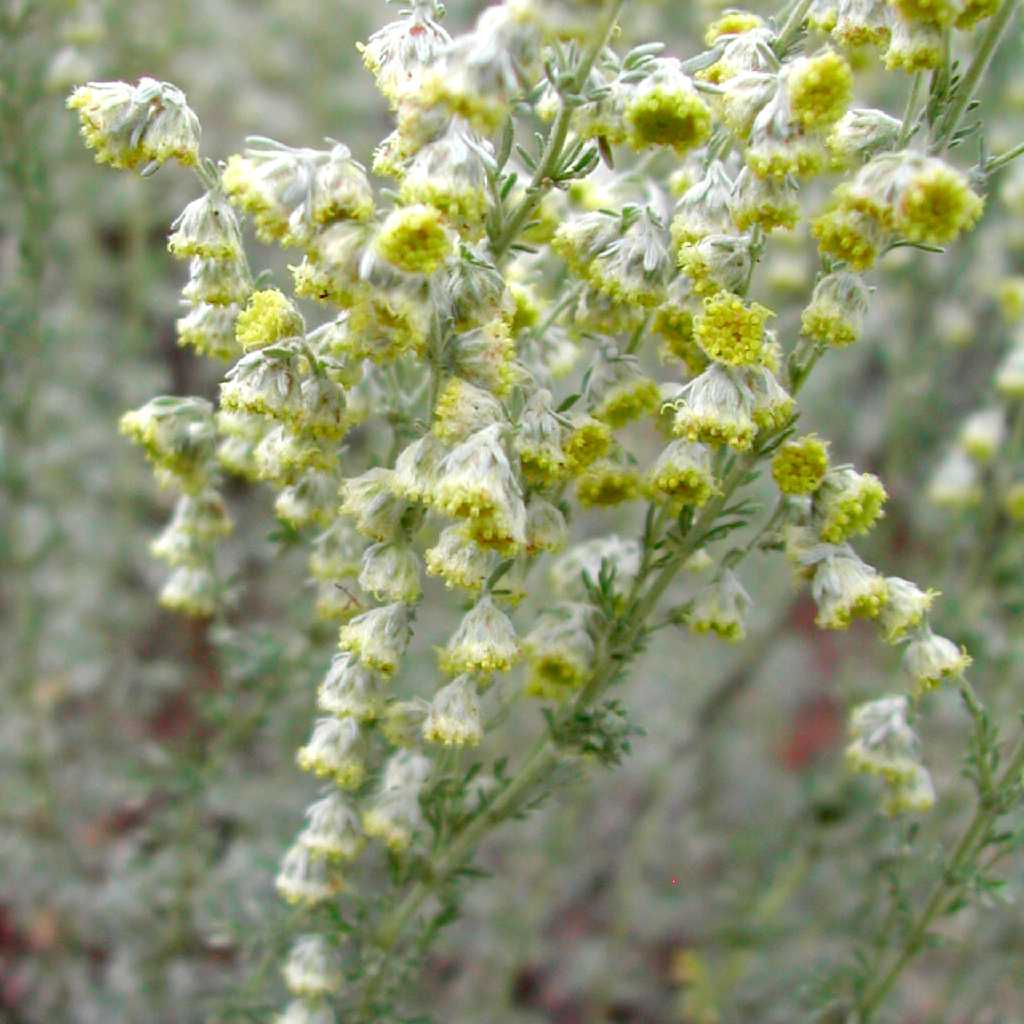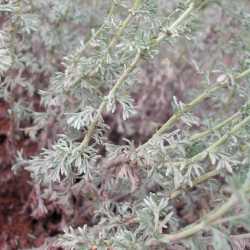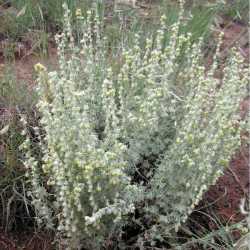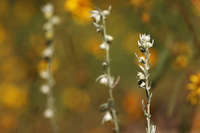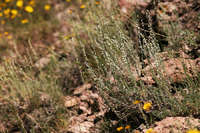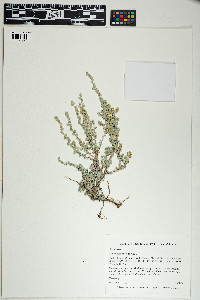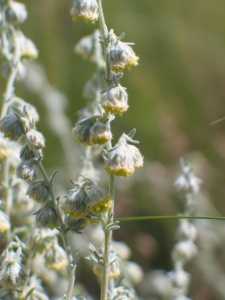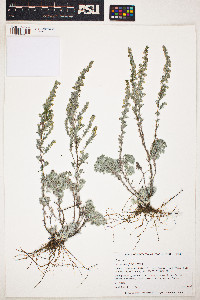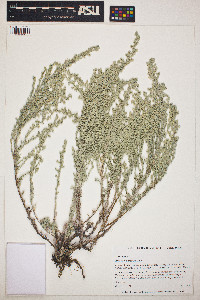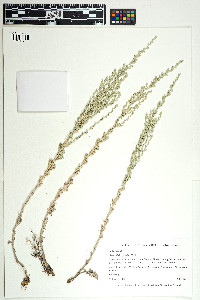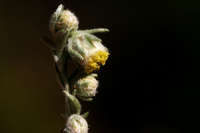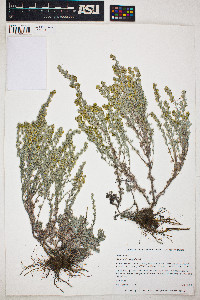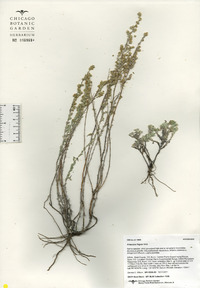|
|
|
|
Family: Asteraceae
prairie sagewort
|
Perennials, 10-40 cm (forming silvery mats or mounds), strongly aromatic. Stems gray-green or brown, glabrescent. Leaves persistent, silver-gray; blades ovate, 0.5-1.5(-2.5) cm, 1-2-ternately lobed (lobes 0.2-0.5 mm wide), faces densely whitish-pubescent. Heads in (leafy) paniculiform arrays 0.5-2(-4) × 4-15(-20) cm. Involucres globose, (3-)5 × (2-)5-6 mm. Phyllaries gray-green (margins sometimes brownish), densely tomentose. Florets: pistillate 10-17; bisexual 20-50; corollas 1.5-2 mm, glabrous. Cypselae 1-1.5 mm, glabrous. 2n = 18. Flowering summer-fall. Fields, meadows, dry grasslands, steppes, usually stony, well-drained soils; 500-3300 m; Alta., B.C., Man., N.B., N.W.T., Nunavut, Ont., Que., Sask., Yukon; Alaska, Ariz., Colo., Idaho, Ill., Iowa, Kans., Minn., Mont., Nebr., N.Mex., N.Dak., S.Dak., Tex., Utah, Wash., Wis., Wyo.; Eurasia. Reports of Artemisia frigida from eastern Canada (Ontario eastward), the eastern United States (e.g., Connecticut, Massachusetts, Michigan, Vermont), and Arkansas and Missouri appear to be from old garden sites where the plants may persist. The similarity of this native species to cultivars from eastern Asia (especially Siberia) has led to a number of reports that are apparently based on other cultivars. As a plant with attractive silver foliage, this species has good potential as a drought-hardy plant for flower gardens in cold climates.
Mat-forming perennial 1-4 dm, from a stout caudex or woody crown, somewhat shrubby at base; lvs small and numerous, clustered at base and well distributed along the stem, sericeous-tomentose, the blade 5-12 mm, twice or thrice ternately divided into linear or linear-filiform divisions 1 mm wide or less, commonly with a pair of simple or trifid stipule-like divisions at the base; infl paniculiform, or racemiform in depauperate plants; invol 2-3 mm; receptacle with numerous long hairs; achenes narrowed to the base, truncate above, obscurely if at all nerved; 2n=18. Prairies and dry open places; sw. Wis., Io. and Kans. to Ariz., Alaska, and Siberia, and occasionally intr. eastward. July-Sept. Gleason, Henry A. & Cronquist, Arthur J. 1991. Manual of vascular plants of northeastern United States and adjacent Canada. lxxv + 910 pp. ©The New York Botanical Garden. All rights reserved. Used by permission. Springer et al. 2011, Kearney and Peebles 1979, FNA 2006, Heil et al 2013, Allred 2013, McDougall 1973, Weber and Wittmann 2012 Common Name: prairie sagewort Duration: Perennial Nativity: Native Lifeform: Subshrub General: Strongly aromatic subshrub, sometimes merely herbaceous from a woody base, 10-40 cm tall, often forming silvery mounds or mats; stems gray-green or brown, nearly glabrous to tomentose. Leaves: Basal and alternate-cauline, sessile or short-petiolate, evergreen; blades 1-2 times ternately lobed, the lobes linear to filiform, 0.2-0.5 mm wide; cauline blades less dissected than basal leaves; entire leaf 0.5-1.5 cm long, surfaces densely white or silvery-pubescent. Flowers: Flower heads disciform, arranged in leafy panicles; involucre (the ring of bracts surrounding the flower head) rounded, 2-3 mm long, 4-6 mm wide, bracts (phyllaries) numerous, in 4-7 series, gray-green, densely tomentose; florets all discs, 2 mm long, with pale yellow corollas, the outer 10-17 florets pistillate, the inner 20-50 florets bisexual. Fruits: Achenes obovate to oblanceolate, 1-1.5 mm long, somewhat compressed, smooth, shiny, faintly nerved, glabrous. Ecology: Found in rocky, well drained soils, on dry meadows and hillsides, in desert scrub, juniper woodlands, and Ponderosa pine forests from 5,500-10,000 ft (1676-3048 m), flowers July-October Distribution: AK to Quebec, south to AZ, NM, and TX; Siberia. Notes: Artemisia frigida is a low, silvery, mound shaped plant that toes the line between subshrub and perennial herb. It is classified as a woody plant in many of the southwestern keys, with a note that it can be merely herbaceous from a woody caudex. Look for the soft, feathery, densely pubescent silver leaves divided and redivided into many short, delicate, narrow lobes 0.5 mm wide or less; these leaves dense along the stems; and slender erect panicles. It is a primarily northern species, reaching into the US Southwest at higher elevations, and common along the harsh, windswept ridges of the Colorado Plateau. The species is drought tolerant; it is top-killed by fire, but may resprout afterwards. There is conflicting evidence of its desirability as a browse species and it has long been considered an indicator of overgrazing. However, recent evidence seems to indicate that it has high desirability as browse, particularly in winter. It is a host plant for the painted lady butterfly. Ethnobotany: Tea from the leaves is used by many tribes to treat cough and cold symptoms. The leaves are used by the Blackfoot and Hopi to sweeten corn. Many tribes use the plant to treat heavy bleeding. The Ramah Navajo used it ceremonially. Etymology: Artemisia is named for Artemis, the Greek goddess of the hunt and namesake of Artemisia, queen of Anatolia; frigida means cold, referring to the species- northern distribution. Synonyms: - - - Editor: AHazelton 2015 |
|
|
|


